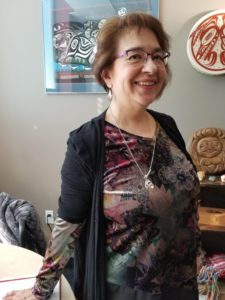The South Island Prosperity Partnership (SIPP, formerly known as the South Island Prosperity Project) and Camosun College have partnered on a proposal that will focus on improving transportation to and from school for students living in rural Indigenous communities. The two organizations are finalists in the Smart Cities Challenge, a government-funded competition encouraging communities to improve the lives of their residents through innovation, data, and connected technology. If they win, they will be awarded $10 million to implement what they call the Indigenous Microtransit Pilot.
Camosun director of Indigenous Education & Community Connections (Eyēʔ Sqȃ’lewen) Janice Simcoe says that SIPP and Camosun agreed that the four villages of the W̱SÁNEĆ Nation are currently facing the biggest challenge when it comes to transportation and post-secondary.
“The group of Indigenous students that have the greatest challenge with transportation in regards to their attendance at Camosun are students who live in the four Indigenous villages of the W̱SÁNEĆ Nation—that’s Pauquachin, Tseycum, Tsartlip, and Tsawout,” says Simcoe. “Their homes are often quite a long distance from bus routes, and then when they do get to the bus route, the route can be really quite circular. There’s a number of students that live in one of these villages and attend Lansdowne, and it takes them an hour and a half each way to get to school.”

SIPP interim CEO Bruce Williams says that the Smart Cities Challenge is about making cities smarter by improving residents’ quality of life.
“The federal government has a big fat bag of money that they’ve put forward for municipalities and regions to use data and technology to make themselves smarter, to address issues that are barriers to quality of life and economic success,” says Williams.
Williams says this pilot aims to accomplish the goals set out by the challenge by connecting people who are living in isolated communities and are not being offered the access to transportation that those living in more urban areas may take for granted.
“[The Indigenous Microtransit Pilot] would mean enhanced engagement and mobility for Indigenous people around the region who don’t have the same access to transportation that many of us do,” he says. “There are some reserve areas, for example, that don’t have transit service. There are even some that don’t have cell service. It isolates them, it encumbers their ability to engage within the economy for education, for healthcare, for social reasons, family reasons, safety reasons.”
The Indigenous Microtransit Pilot will address these issues by creating a sort of transportation network, according to Williams, that will enable Indigenous people, particularly those in more isolated areas, to get around better.
“For example, one of the Nations is the Scia’new, or the Beecher Bay First Nations,” says Williams. “They’re located just past Metchosin. There is no transit service to them, so if they want to get into town for anything, if they don’t happen to have a personal vehicle or the resources to put gas in a vehicle, they have to hitchhike. So students hitchhike to school, or they hitchhike to shop, or they call a cab, which is really expensive, and to call a cab they have to actually take their phone to the band office where there’s Wi-Fi, because that’s the only way they can get the call made.”
Williams says that the Indigenous Microtransit Pilot will create a network of vehicles operated by drivers who will be trained by BC Transit.
“Many of the Nations—the Songhees, the Pauquachin, Tsartlip—have their own vehicles,” says Williams. “There’s a whole network of them that could be made available. Or vehicles would be crafted or acquired for that purpose, and there would be training in place through BC Transit to help them best operate those vehicles, and then there would be studies and research done to determine whether a regular service or an on-demand service, or a combination of those, would be the best way to make it work.”
Camosun will recruit and employ a co-op student to assist with this program; according to Simcoe, the position will likely focus on gathering information.
“I think it’ll be primarily information provision,” says Simcoe. “This is what you need to do, you know—gathering information about how to set up the process, and what will work best for the current and potential students that the project will support—and then once that is set up, then it’s information about what will be available.”
Camosun College Student Society (CCSS) clubs and events assistant Quinn Park says that the CCSS supports any initiative that increases access to higher education.
“At the student society, we are deeply in favour of any program that seeks to get our members to and from their educational goals more easily or more quickly,” says Park, “so it seems like a win for students.”
Simcoe says that increased engagement between Indigenous people and Camosun will help to build a shared understanding between the two, and amongst the student body itself.
“I think the more engagement there is between Indigenous people and the college, the more incentive there is to enhance its programming that has Indigenous perspective in it,” says Simcoe. “I need to hold the college up, for it’s doing that anyway, and doing it beautifully, and I really want to make the point that doing that isn’t just about Indigenous students, it’s about the whole student body. Because part of the goal is that we all learn to work together better and have more shared understanding. So the more that the college develops and delivers that kind of programming, the better for everybody, and when we’ve got more community students in the college, then their needs need to be responded to.”
